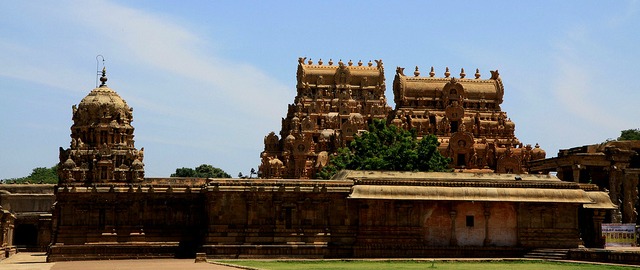
South Indian Temple Architecture : A journey through the centuries
India’s ancient temples are architectural marvels that portray the country’s rich past in terms of history, art and culture. Besides being examples of exquisite craftsmanship, the fact that they were built in an era when there was little or no mechanization adds to their mystique. In South India, the most famous temples are built in the Dravidian style, marked by structures in stone, tall towers, sculptures and intricate inscriptions. They often differ in design and style from one era to the next due to the diverse influences of several ruling dynasties.
From early cave temples that were carved from sandstone hills, the architectural design of South Indian temples slowly evolved to rock cut temples and finally, standalone structural temples that grew larger, both in terms of the area of the complexes as well as the height of the towers or vimanas. The best examples of these can be seen in Tamil Nadu and Karnataka.
Aihole, Badami and Pattadakkal
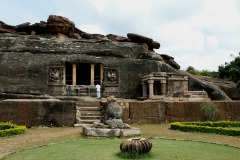 As capitals of the Chalukya dynasty, these three ancient cities have many temples, which were built from the 6th-8th century AD. The most notable one is Ravana Phadi, a Shaivite cave temple in Aihole. Badami – an early capital of the Chalukyas – also has four cave temples, which are of the same vintage as the ones in Aihole, but are characterized by a more developed style with better finished interiors, including beautifully carved ceilings, a pillared entrance verandah, a hall with columns and a sanctum sanctorum, where the deity rests.
As capitals of the Chalukya dynasty, these three ancient cities have many temples, which were built from the 6th-8th century AD. The most notable one is Ravana Phadi, a Shaivite cave temple in Aihole. Badami – an early capital of the Chalukyas – also has four cave temples, which are of the same vintage as the ones in Aihole, but are characterized by a more developed style with better finished interiors, including beautifully carved ceilings, a pillared entrance verandah, a hall with columns and a sanctum sanctorum, where the deity rests.
Structural temples, such as the 5th century Lad Khan  temple and the 7th century Hucchimali Gudi and Durga Temple in Aihole as well as the 6th century Malegitti Shivalaya temple in Badami present the second phase of a temple architecture of the Chalukya period, which featured Dravidian style tiered towers or vimanas.
temple and the 7th century Hucchimali Gudi and Durga Temple in Aihole as well as the 6th century Malegitti Shivalaya temple in Badami present the second phase of a temple architecture of the Chalukya period, which featured Dravidian style tiered towers or vimanas.
Pattadakal is a UNESCO World Heritage site, which has temples that represent the final stage of the Chalukya architecture. These were built in the 8th century and feature four temples with Dravidian architecture and four in the Nagara style from North India. The town displays the Vesara architectural style that combines northern and southern influences. The Bhuttanatha temples near the Agastya-Tirtha Lake in Badami also belong to the same period.
Mahabalipuram
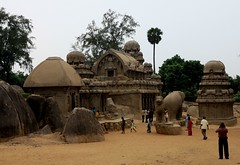 The 7th century chariot or ratha style of temples in Mahabalipuram (another UNESCO site) in Tamil Nadu is one of the oldest monolithic rock-cut structures. Built by the Pallava kings, there are five of these marvels, each cut from a single stone. They are named after the Pandavas (from the epic Mahabharata) and their wife Drapuadi.
The 7th century chariot or ratha style of temples in Mahabalipuram (another UNESCO site) in Tamil Nadu is one of the oldest monolithic rock-cut structures. Built by the Pallava kings, there are five of these marvels, each cut from a single stone. They are named after the Pandavas (from the epic Mahabharata) and their wife Drapuadi.
The 8th century Shore Temple in Mahabalipuram is the earliest free standing structural temple made from stone, which was also built by the Pallavas, who are credited with developing Dravidian architecture as we know it today. Its pyramid-shaped tower with five stories and a dome or shikara at the top, became the trademark of Dravidian temple architecture with large complexes within which multiple shrines were located. The temple has three shrines, two of which are dedicated to Lord Shiva, while the third has the deity of Lord Vishnu in a reclining pose.
Kanchipuram
The Kailasanath Temple in Kanchipuram was also built in the 8th century by a Pallava king, but with a more evolved style than the Mahabalipuram Shore Temple. It has larger dimensions, a pillared hall, a vestibule and an inner sanctum, around which nine smaller shrines are located.
Thanjavur
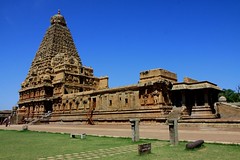 As the years went by, temples in South India became larger both in terms of the height of the gopuram or entrance gateways as well as the size of the complex. Notable among this is the Brihadeeswara temple in Thanjavur, which was built in the 11th century and has one of the tallest vimanas or towers (66 meters high).
As the years went by, temples in South India became larger both in terms of the height of the gopuram or entrance gateways as well as the size of the complex. Notable among this is the Brihadeeswara temple in Thanjavur, which was built in the 11th century and has one of the tallest vimanas or towers (66 meters high).
Madurai
The famous Meenakshi Amman temple in Madurai was built initially by the Pandyas in the 6th century and subsequently, rebuilt from ruins between the 16th and 18th centuries by the Nayaks. The most noticeable feature of this Dravidian style temple is the presence of twelve gopurams or towers.
Srirangam
 Spread over 156 acres, the Sri Ranganathaswamy temple in Srirangam is the largest functioning temple complex in the world and was built by an early Chola King. It’s considered one of the most important temples of the Vaishnavites.
Spread over 156 acres, the Sri Ranganathaswamy temple in Srirangam is the largest functioning temple complex in the world and was built by an early Chola King. It’s considered one of the most important temples of the Vaishnavites.
Rameswaram
Built by a Pandya king in the 12th century, the Ramanathaswamy Temple has the longest corridor among all Indian temples. Located on an island in the southernmost tip of the Indian peninsula, it’s a place of pilgrimage for both Shaivites and Vaishnavites.
Hampi
As the capital of the Vijayanagara Empire from the 14th to 16th centuries, Hampi has several temple complexes. The best known of this is the Virupaksha Temple, with its Dravidian style entrance tower that predates the foundation of the empire. The Vittala temple, with its monolithic stone chariot and musical pillars, is another attraction.
Belur and Halebid
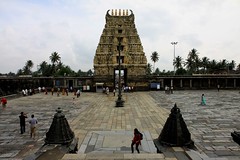 The Hoysala temples in Belur and Halebid, which were built in the 12th century, have influences of southern Dravidian as well as Aryan architecture from the north. They are renowned for the sculptures that adorn the temples from the floor to the ceiling.
The Hoysala temples in Belur and Halebid, which were built in the 12th century, have influences of southern Dravidian as well as Aryan architecture from the north. They are renowned for the sculptures that adorn the temples from the floor to the ceiling.
Visiting the ancient temples of South India is as much of a lesson in history as it is in architecture. Besides the stylistic influences of the architects of each era, who received royal patronage, they also depict the religious history of the region – the progression from early Buddhist influences to the Hinduism, and the subsequent struggle for power between the Shaivite and Vaishnavite sects. As each ruler tried to outdo his predecessor, temples evolved from simple structures to larger complexes bound by walls with several shrines and halls within. The resulting grandeur is a splendid sight and has placed South Indian temples among the top architectural wonders of India.


No comments yet.